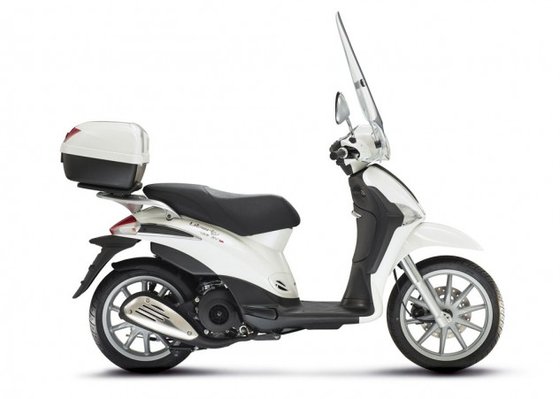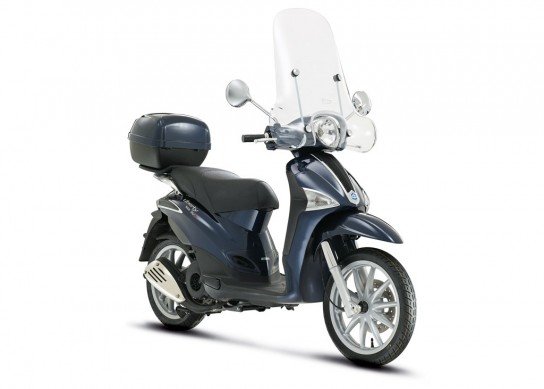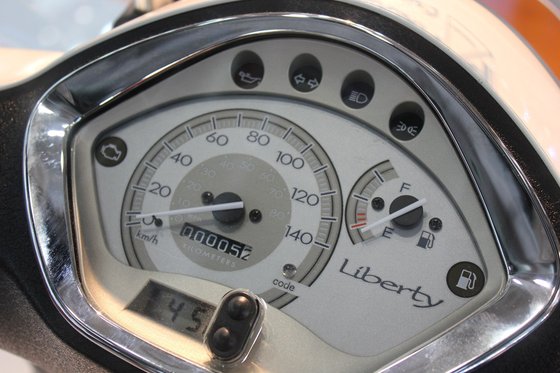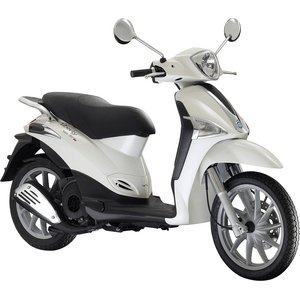Piaggio Liberty 125 [2014-2015] Review: Urban Elegance Meets Everyday Practicality

Introduction
The Piaggio Liberty 125 3V (2014-2015) is a scooter that embodies the essence of urban mobility. Designed for riders who prioritize practicality without sacrificing style, this generation of the Liberty refined Piaggio’s formula for city commuting. With its blend of Italian design, fuel efficiency, and user-friendly features, it’s a scooter that feels as at home zipping through narrow streets as it does on longer suburban rides. Having spent time with this model, it’s clear that Piaggio aimed to create a machine that’s both accessible for new riders and satisfying for seasoned commuters. Let’s dive into what makes this scooter stand out—and where it fits in the crowded 125cc segment.
Design & Ergonomics: Metropolitan Sophistication

The Liberty 125’s design is a masterclass in understated elegance. Its lines are clean and modern, with chrome accents on the front apron and a trapezoidal headlight that gives it a slightly assertive face. The 2014-2015 model retained the classic “tie” design element—a Piaggio hallmark—but introduced subtle updates like a reshaped seat and smaller 15-inch front wheel (down from 16 inches in earlier models). These changes weren’t just cosmetic: the shorter wheelbase (1,345 mm / 53.0 in) and narrower front tire (80/90-15) improved maneuverability without sacrificing stability.
Seat & Riding Position
The seat height of 790 mm (31.1 in) is a godsend for shorter riders. During my test ride, planting both feet firmly on the ground at stops felt natural, even for someone standing 170 cm (5’7”). The seat itself uses a new foam compound that’s firm yet supportive—a balance that pays off during 45-minute commutes. The tapered rear section also makes sliding on and off easier, whether you’re wearing office attire or jeans.
Practical Touches
Piaggio nailed the details that matter for daily use:
- Under-seat storage: 10.8 liters (up 23% from prior models) fits a full-face helmet or a week’s worth of groceries.
- Leg shield compartments: Small but perfect for stashing a phone or wallet.
- Bag hook: A simple yet genius addition for securing backpacks or shopping bags.
The Bianco Perla (pearl white) and Blu Midnight color options particularly highlight the scooter’s curves, though the Nero Grafite (graphite black) hides urban grime better between washes.
Engine & Performance: Smooth Operator

At the heart of the Liberty 125 is a 124 cc single-cylinder, 3-valve engine with electronic fuel injection. This isn’t a powerhouse—7.6 kW (10.3 hp) at 7,500 rpm and 10.4 Nm (7.67 lb-ft) of torque at 6,000 rpm—but it’s tuned for the real world. Throttle response is immediate, and the CVT transmission delivers seamless acceleration from a standstill.
City Riding
In stop-and-go traffic, the Liberty shines. The engine pulls cleanly from idle, reaching 50 km/h (31 mph) in about 6 seconds—enough to keep pace with urban traffic. The real joy is in its smoothness; there’s no jerkiness when rolling on/off the throttle, making it ideal for congested streets.
Open-Road Manners
The Liberty’s top speed of 95 km/h (59 mph) means it can handle faster roads, but it’s happiest below 80 km/h (50 mph). At higher speeds, the engine feels buzzy, though vibrations are well-damped by the rubber-mounted footpegs. Fuel efficiency is stellar: Piaggio claims 3.3 L/100 km (71 mpg), and during mixed riding, I averaged 3.6 L/100 km (65 mpg). With a 6.5 L (1.7 US gal) tank, that’s a 180 km (112 mi) range—perfect for weekly commutes.
The 3-Valve Advantage
The 3-valve head (two intake, one exhaust) improves combustion efficiency. Compared to 2-valve rivals, the Liberty feels more eager at low RPMs, reducing the need to rev hard during uphill climbs. Paired with the torque-sensing CVT (“torque server”), it maintains momentum even with a passenger.
Handling & Braking: Agile Yet Composed
The Liberty’s chassis is a tubular steel single cradle frame—sturdy but not bulky. The 15-inch front and 14-inch rear wheels strike a balance between agility (smaller wheels) and stability (larger than typical 12-inch scooter wheels).
Urban Agility
Flicking the Liberty through traffic is effortless. The handlebar is wide enough for leverage but narrow enough to filter through gaps. At 121 kg (267 lbs) wet, it’s light enough to push around parking lots yet feels planted at speed.
Suspension Tuning
The telescopic front fork and preload-adjustable rear shock handle city potholes admirably. Over cobblestones, the front end stays composed, though sharp bumps can jolt through the seat. Preload adjustment on the rear shock lets you tailor the ride for solo or two-up riding.
Braking Performance
The 240 mm front disc (hydraulic) provides confident stopping power, while the 140 mm rear drum is adequate for most scenarios. Brake feel is linear, and combined with the grippy IRC tires, the Liberty stops from 50 km/h (31 mph) in a respectable 14 meters (46 ft). ABS wasn’t offered, so smooth inputs are key in wet conditions.
Competition: How It Stacks Up
The 125cc scooter market is fiercely competitive. Here’s how the Liberty 125 3V compares:
1. Honda SH125i
- Pros: Larger 16-inch wheels, liquid-cooled engine, optional ABS.
- Cons: Pricier, bulkier design.
Verdict: The SH125i is more refined at highway speeds, but the Liberty wins on price and storage.
2. Yamaha NMAX 125
- Pros: Liquid-cooling, Bluetooth connectivity, sharper styling.
- Cons: Less under-seat storage, higher seat (765 mm / 30.1 in).
Verdict: The NMAX appeals to tech lovers, but the Liberty feels nimbler in tight spaces.
3. Vespa Primavera 125
- Pros: Iconic steel body, premium build quality.
- Cons: Heavier (124 kg / 273 lbs), smaller wheels (12-inch).
Verdict: The Vespa oozes style, but the Liberty offers better value and practicality.
Liberty’s Edge: It splits the difference between premium Euro scooters and budget Asian models. The air-cooled engine lacks the tech of liquid-cooled rivals but compensates with lower maintenance costs.
Maintenance: Keeping Your Liberty Happy
The Liberty 125 is built for low upkeep, but a few key areas deserve attention:
1. Belt & CVT System
The CVT belt should be inspected every 12,000 km (7,500 mi) and replaced around 24,000 km (15,000 mi). MOTOPARTS.store offers OEM-spec and high-performance belts for smoother acceleration.
2. Oil Changes
Piaggio recommends 10W-40 oil changes every 6,000 km (3,700 mi) or annually. The wet sump system makes DIY changes straightforward.
3. Brake Care
- Front Pads: Replace when worn to 1.5 mm thickness.
- Rear Drum: Adjust the cable tension every 5,000 km (3,100 mi).
4. Tires
The stock IRC tires are durable but consider upgrading to Michelin City Grip for wet weather confidence.
5. Air Filter
Clean every 4,000 km (2,500 mi); replace every 12,000 km (7,500 mi). A high-flow filter (available at MOTOPARTS.store) can boost mid-range response.
Pro Tip: Use DOT 4 brake fluid and check levels annually. The forced-air cooling system requires no coolant changes—just keep the intake vents clean.
Final Thoughts
The Piaggio Liberty 125 3V (2014-2015) isn’t about breaking boundaries—it’s about mastering the basics. From its fuss-free engine to the thoughtful storage solutions, every detail caters to urban riders who value simplicity. While it won’t thrill adrenaline junkies, it delivers exactly what it promises: a reliable, stylish, and economical way to conquer the city.
For owners looking to enhance their Liberty, MOTOPARTS.store stocks everything from premium brake pads to custom seat covers. Whether you’re maintaining stock reliability or adding personal flair, this scooter rewards those who treat it well.
Specifications sheet
| Engine | |
|---|---|
| Stroke: | Four-stroke |
| Max power: | 8 kW | 11.0 hp |
| Max torque: | 10 Nm |
| Fuel system: | Electronic fuel injection |
| Lubrication: | Wet sump |
| Max power @: | 7500 rpm |
| Displacement: | 124 ccm |
| Max torque @: | 6000 rpm |
| Configuration: | Single |
| Cooling system: | Forced air |
| Compression ratio: | N/A |
| Number of cylinders: | 1 |
| Dimensions | |
|---|---|
| Wheelbase: | 1345 mm (53.0 in) |
| Dry weight: | 121 |
| Seat height: | 790 mm (31.1 in) |
| Overall width: | 700 mm (27.6 in) |
| Overall length: | 1920 mm (75.5 in) |
| Fuel tank capacity: | 6.5 L (1.7 US gal) |
| Drivetrain | |
|---|---|
| Clutch: | Automatic centrifugal dry clutch |
| Final drive: | belt |
| Transmission: | CVT with torque server |
| Maintenance | |
|---|---|
| Brake fluid: | DOT 4 |
| Spark plugs: | N/A |
| Under-seat storage: | 10.8 L |
| Valve clearance check interval: | N/A |
| Additional Features | |
|---|---|
| Wheels: | 15-inch front / 14-inch rear |
| Storage: | Compartments behind leg shield, bag hook |
| Security: | Standard electronic immobilizer |
| Instrumentation: | Clear instrument panel |



















